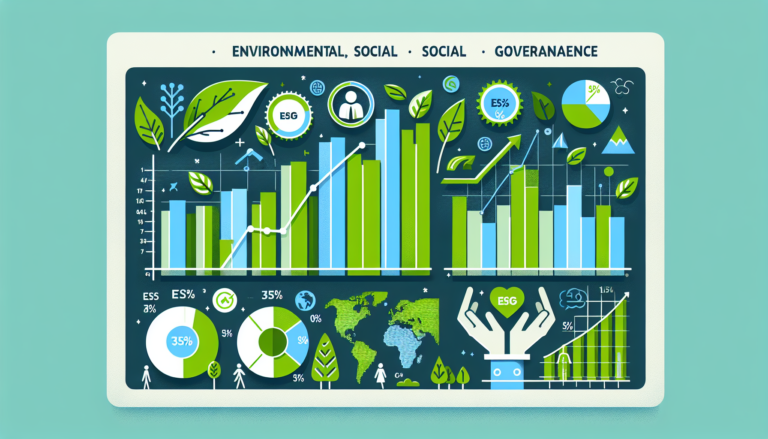Understanding esg sustainability reporting for businesses
ESG sustainability reporting involves disclosing a company’s environmental, social, and governance practices, which enhances transparency, attracts investors, and improves risk management, ultimately driving corporate accountability and positively affecting long-term success.
ESG sustainability report is essential for organizations aiming to be transparent and accountable. By understanding its significance, businesses can enhance their operations and stakeholder trust.
Defining ESG and its importance
ESG, which stands for Environmental, Social, and Governance, refers to the three central factors used to measure the sustainability and societal impact of an investment in a company. Understanding ESG is crucial for businesses and investors alike. It enables the evaluation of how a company manages risks and opportunities related to environmental and social criteria.
The importance of ESG lies not just in ethical considerations but also in financial performance. Companies that effectively manage ESG factors can reduce costs, enhance their brand reputation, and comply with regulations, leading to superior long-term returns. For instance, organizations adopting sustainable practices often see a decrease in waste and energy costs.
Moreover, a strong ESG profile can attract more investors. Today, many investors are choosing to put their money into companies committed to sustainability and social responsibility. This shift indicates that addressing ESG issues is not only a moral obligation but also a sound business strategy.
Therefore, defining ESG and understanding its significance can serve as a roadmap for companies looking to improve their practices. Businesses venturing into ESG reporting can begin by assessing their current policies and identifying areas for improvement, setting the stage for more transparent operations that align with stakeholder expectations.
Key components of sustainability reports
Sustainability reports provide a detailed overview of a company’s performance regarding its environmental, social, and governance (ESG) commitments. The key components of these reports are essential for understanding how organizations measure and communicate their efforts.
Firstly, an executive summary outlines the main findings and achievements, offering stakeholders an overview of the report’s content. This section typically highlights significant statistics and notable initiatives that reflect the company’s sustainability journey.
Another critical component is metric reporting, where organizations disclose specific quantitative measures related to their sustainability goals. This includes data on energy usage, carbon emissions, and waste management, allowing for transparent evaluation over time.
Furthermore, stakeholder engagement is vital in sustainability reports. Companies must detail how they interact with communities, customers, and employees to foster inclusivity and responsiveness. This engagement ensures the reports address the concerns and expectations of all relevant parties.
Lastly, the inclusion of governance structures that oversee sustainability efforts demonstrates accountability. This component establishes who is responsible for implementing sustainability initiatives and tracking progress, reinforcing the organization’s commitment to their ESG objectives.
How to prepare an effective ESG report
Preparing an effective ESG report requires a strategic approach and attention to detail. Start by defining the purpose of the report. This will guide what information to include and how to present it. An impactful report should align with the company’s overall goals and resonate with stakeholders.
Next, gather relevant data. Focus on quantitative metrics such as greenhouse gas emissions, energy consumption, and employee turnover rates. Qualitative information, such as community engagement initiatives and ethical sourcing practices, also plays a crucial role.
Incorporating stakeholder feedback is essential. Engage with employees, investors, and community members to understand their concerns and expectations. This engagement not only enriches the content but also demonstrates transparency and a commitment to accountability.
Utilizing a clear structure in your report enhances readability. Consider organizing sections by ESG categories—environmental, social, and governance. Each section should contain clear headings and concise descriptions, making it easy for readers to navigate.
Lastly, ensure your report follows recognized reporting standards, such as the Global Reporting Initiative (GRI) or the Sustainability Accounting Standards Board (SASB). Adhering to these frameworks enhances credibility and allows for comparability with other organizations.
Benefits of ESG reporting for businesses
ESG reporting offers significant benefits for businesses, enhancing their reputation and operational efficiency. By transparently communicating their environmental, social, and governance practices, organizations can build stronger relationships with stakeholders, including customers, employees, and investors.
One major advantage is improved risk management. Companies that actively monitor and report on ESG factors are better equipped to identify potential risks related to climate change, regulatory compliance, and social issues. This proactive approach helps mitigate risks before they escalate into crises.
Moreover, businesses that commit to ESG reporting often experience enhanced financial performance. Studies have shown that companies with robust sustainability practices tend to outperform their peers. This performance boost can be attributed to cost savings from energy efficiency, improved resource management, and stronger consumer loyalty.
Furthermore, ESG reporting can attract investment opportunities. Many investors now prioritize companies with sustainable practices, viewing them as less risky and more likely to succeed in the long term. Companies that showcase their commitment to ESG can tap into a growing pool of socially conscious investors.
Lastly, effective ESG reporting can foster a positive corporate culture. By engaging employees in sustainability initiatives, businesses can boost morale and attract top talent, contributing to a more motivated and productive workforce.
Challenges in ESG sustainability reporting
Challenges in ESG sustainability reporting can significantly hinder a company’s ability to effectively communicate its sustainability practices. One major issue is the lack of standardization in reporting guidelines. Organizations often face uncertainty about what metrics to include, leading to inconsistent reporting that can confuse stakeholders.
An additional challenge is the data collection process. Gathering accurate and comprehensive data requires robust systems and resources. Many companies struggle to track and analyze the necessary information, resulting in gaps in their reports.
Moreover, companies may encounter resource constraints, particularly smaller businesses that lack the financial and human capital to invest in ESG reporting initiatives. This limitation can prevent them from fully understanding their impacts and improving their practices.
Another significant hurdle is the communication of ESG practices. Effectively conveying complex sustainability issues to diverse stakeholders can be difficult. Companies must tailor their messaging to resonate with different audiences while also maintaining transparency and credibility.
Finally, the evolving landscape of regulations presents challenges, as companies need to adapt their reporting strategies to comply with changing laws. Staying informed and agile in response to regulatory requirements is essential for effective ESG reporting.
Best practices for transparency and accountability
Implementing best practices for transparency and accountability in ESG reporting is essential for building trust with stakeholders. First, organizations should establish clear communication channels to disseminate information about their sustainability initiatives. Regular updates through newsletters, social media, and dedicated sections on company websites can enhance engagement.
Another important practice is ensuring that reports are accessible and understandable. Companies should avoid jargon and present data in a straightforward manner, using visual aids like graphs and charts. This approach can help stakeholders easily digest complex information.
Additionally, organizations should prioritize stakeholder engagement. Actively seeking input from employees, investors, and community members fosters transparency. Conducting surveys or hosting forums can collect valuable feedback, demonstrating that the organization values diverse perspectives.
Moreover, companies must adhere to recognized reporting standards such as GRI or SASB. Following these frameworks not only enhances the credibility of reports but also enables investors to make informed decisions based on consistent data.
Finally, establishing a culture of accountability is crucial. Companies should set clear goals aligned with their ESG strategy and regularly assess their progress. By openly acknowledging achievements and areas for improvement, businesses can demonstrate their commitment to transparency and responsible governance.
ESG reporting frameworks and standards
Understanding ESG reporting frameworks and standards is crucial for companies aiming to enhance their sustainability practices. These frameworks provide guidelines to help organizations measure, document, and report their environmental, social, and governance performance effectively.
One of the most widely adopted frameworks is the Global Reporting Initiative (GRI). The GRI offers a comprehensive set of standards that help businesses disclose their sustainability impacts clearly and consistently. This framework encourages transparency and accountability, enabling stakeholders to assess a company’s performance and commitment.
Another important framework is the Sustainability Accounting Standards Board (SASB), which tailors its standards to different industries. SASB focuses on material sustainability issues that are likely to impact financial performance and is designed for use by investors and companies alike, promoting greater understanding of ESG risks.
Additionally, the Task Force on Climate-related Financial Disclosures (TCFD) provides important guidelines focused specifically on climate-related risks and opportunities. Its recommendations help organizations disclose relevant financial information related to climate change, aiding investors in assessing risk exposure.
Finally, by adhering to these frameworks, companies can improve their credibility and engage more effectively with stakeholders. Integrating these reporting standards into business operations is essential for achieving long-term sustainability and trust within the marketplace.
Future trends in ESG reporting
The landscape of ESG reporting is rapidly evolving, with several key future trends emerging that will reshape how companies approach sustainability. One significant trend is the increasing demand for real-time data reporting. Stakeholders now expect organizations to provide more timely and accurate information regarding their ESG performance, leading to the adoption of advanced technologies that can facilitate real-time data collection and analysis.
Another important trend is the shift towards integrated reporting. Companies are beginning to merge traditional financial reports with ESG disclosures, creating a comprehensive overview of their performance. This integrated approach not only enhances transparency but also allows stakeholders to see how sustainability impacts financial viability.
Furthermore, there is a growing emphasis on climate risk assessment. Regulatory bodies are increasingly requiring companies to evaluate and disclose their vulnerabilities to climate change. This trend drives organizations to adopt better risk management strategies and develop sustainable practices that can withstand environmental challenges.
Another notable trend is the rise of stakeholder activism. Investors, consumers, and employees are becoming more vocal about their expectations concerning corporate responsibility. As a result, companies can no longer afford to ignore ESG issues, as stakeholder influence now plays a critical role in shaping corporate policy.
Finally, the integration of artificial intelligence and machine learning into ESG analysis is on the rise. These technologies enhance the ability to analyze vast amounts of data, providing deeper insights into corporate performance and sustainability efforts.
Frequently Asked Questions
What is ESG reporting and why is it important?
ESG reporting involves disclosing a company’s environmental, social, and governance practices, which helps stakeholders understand the company’s commitment to sustainability and responsibility.
How do ESG frameworks enhance corporate transparency?
ESG frameworks provide standardized guidelines for reporting, which improves the consistency and clarity of disclosures, fostering trust and transparency with stakeholders.
What are some common ESG reporting frameworks?
Common ESG reporting frameworks include the Global Reporting Initiative (GRI), Sustainability Accounting Standards Board (SASB), and Task Force on Climate-related Financial Disclosures (TCFD), each serving different reporting needs.
What are the key benefits of effective ESG reporting?
Effective ESG reporting can improve a company’s reputation, attract investors, enhance risk management, and promote better engagement with stakeholders, ultimately driving long-term success.
What challenges do companies face in ESG reporting?
Companies often face challenges such as lack of standardization, data collection difficulties, resource constraints, and evolving regulatory requirements, which can complicate the reporting process.
How can technology aid in ESG reporting?
Technology can aid in ESG reporting by facilitating real-time data collection, enabling advanced analytics, and improving the accuracy and efficiency of reporting processes.






